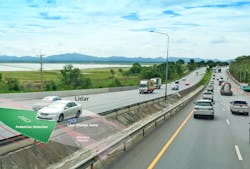While widespread commercial availability of level 4 and level 5 autonomy still has its share of hurdles to conquer, autonomous solutions are not new to the automotive world. Most vehicles on the road today are equipped with various levels of driver assistance, with partial and conditional automation each gaining in popularity.
Why is this important? It leads to acceptance, familiarity, and comfort as automakers continue to explore opportunities for next-level autonomy, including making decisions on which technology route makes the most sense.
Laser Focus World recently connected with Larry Williams, distinguished engineer with Ansys, to hear his perspective.
LFW: What do you see as the most pressing challenges as autonomy begins gaining favor?
Williams: Autonomous vehicles (AVs)—especially advanced driver-assistance systems (ADAS)—are getting more and more popular, yet they face a myriad of challenges before they’ll be ready for public roads. Arguably, the biggest hurdle will be proving to regulators that an AV’s sensors and artificial intelligence (AI) can operate safely and reliably in real-life driving scenarios that include roadways, other vehicles, pedestrians, varying visibility, and weather conditions, like rain, ice, and snow. Extensive testing is needed to ensure that these vehicles are safe; some estimates suggest nearly nine billion miles of testing would be required, which simply is not physically feasible. To ensure the reliability of AVs, we will need to conduct both physical and simulated testing.
Another challenge to tackle while getting AVs ready for the road is making sure the sensors, cameras, and technology involved are as smart and accurate as possible. How can we make sure that a camera is not just a game rendering of a scene, but actually considers the physics-based attribute of every element? How does light play a role, for example? Camera imaging sensors turn this into real-world data. Ansys is helping OEM companies transition and enter the ADAS and AV space using its simulation tools to answer these important questions before a prototype is even built.
LFW: From simulation models, which optical systems are showing the most promise?
Williams: We’re really excited about the promise of light detection and ranging (LiDAR) technology, an innovative remote sensing method used to map a three-dimensional model of an environment. LiDAR is a technology that can perform similar functions to radar and sonar but can be compared to the metaphorical “eyes” of the vehicle, and its precise data collection and accuracy makes it a preferred remote sensing technology.
While LiDAR can collect data quickly and with high accuracy, it’s not perfect on its own. The main disadvantages to LiDAR are its size and its inability to measure distance through heavy weather, but Ansys’ simulation is further improving this technology and accelerating its development, resulting in an optimized design that satisfies strict industry requirements. Through our multiphysics solutions, we can inform rapid emitter and receiver design and placement optimization, further enhancing the performance of this already effective technology. Earlier this year, we worked with Innoviz Technologies, who used Ansys simulation solutions to engineer its unique automotive-grade, solid-state LiDAR sensor. Our simulation technology helped Innoviz solve its biggest design challenge, which was creating a more compact LiDAR system.
LFW: Do you see LiDAR surfacing as the primary technology as automotive firms move forward with autonomy?
Williams: The best path toward developing safe, reliable AVs involves using multiple sensors that work together. While LiDAR is an important technology and certainly a game-changer with exciting implications, for the best, most well-rounded results, manufacturers need to combine LiDAR with other modalities, like radar and camera sensors.
Where LiDAR uses light pulses to scan an environment, radar uses electromagnetic waves to sense the environment, and can better operate over a long distance in poor visibility or inclement weather conditions. Both radar and LiDAR help an AV map out its surroundings—but since neither sensor is perfect on its own, to achieve the highest level of safety and automation, it’s best to utilize both. While LiDAR is seeing a lot of buzz as of late, impressive work is being done in the radar space, too. Oculii, an AI software platform for radars, is using Ansys tech to develop AI software and hardware for radar systems that will allow AVs to perceive their surroundings more accurately.
LFW: What lessons can optical and laser manufacturers learn from simulation tools as they work to find their place within autonomous technology?
Williams: It is critical that manufacturers understand how their hardware will operate in real-world conditions. Luckily, there are tools and technology available to ensure they are considering critical variables, without requiring extensive—and costly—physical testing.
Physics-based simulation technology enables engineers to troubleshoot throughout a product’s developmental stages. Using simulation, engineers can understand exactly how different road conditions could impact a radar system, how specific weather conditions could affect the visibility of the different sensors, or if the system will meet critical industry standards. Simulation-based trials gives engineers insight into their products that normally could not be gained unless they built and tested a physical prototype.
Simulation also assists with the large challenge of edge cases, which is increasingly important as vehicles move from level 2 and 3 to level 4 automation. They can also help answer important safety questions like, how does a vehicle behave when the driver becomes distracted or something is in the road? We can take those edge cases and run 1000 variations. Instead of broad testing, simulation is required to look for edge cases and conduct significant testing once you find them.
Simply put, developing the most cost-effective, safe AVs while meeting rigorous industry standards requires physics-based simulation technology.
About the Author
Peter Fretty
Market Leader, Digital Infrastructure
Peter Fretty began his role as the Market Leader, Digital Infrastructure in September 2024. He also serves as Group Editorial Director for Laser Focus World and Vision Systems Design, and previously served as Editor in Chief of Laser Focus World from October 2021 to June 2023. Prior to that, he was Technology Editor for IndustryWeek for two years.
As a highly experienced journalist, he has regularly covered advances in manufacturing, information technology, and software. He has written thousands of feature articles, cover stories, and white papers for an assortment of trade journals, business publications, and consumer magazines.

